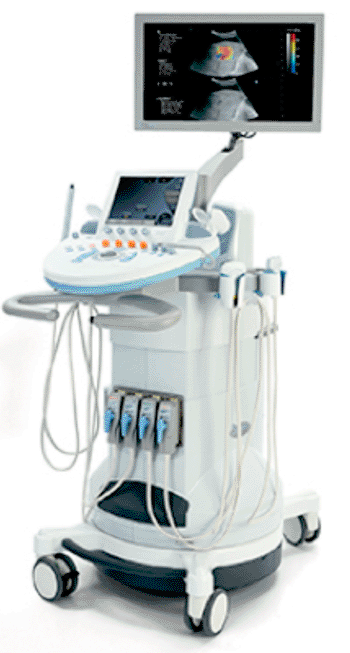Elastography Technique Helps Determine Liver Fibrosis
By MedImaging International staff writers
Posted on 02 Jan 2014
A noninvasive technique visualizes and quantitatively measures tissue stiffness across the different stages of fibrosis leading up to cirrhosis.Posted on 02 Jan 2014
The Aixplorer Ultrasound System with ShearWave Elastography (SWE) can help determine quantitative liver stiffness values in an easy-to-use manner, which can be safely repeated over time to follow disease progression or regression. The system is based on proprietary MultiWave technology, which images two types of waves to better characterize tissue; an ultrasound wave to ensure image quality, and a shear wave to compute and display true tissue stiffness in real time. Broadband technology delivers extremely high-resolution tissue harmonic imaging, which significantly reduces image artifacts and provides better contrast resolution.

Image: The Aixplorer Ultrasound System with SWE (Photo courtesy of SuperSonic Imagine).
The Aixplorer also provides advanced and comprehensive Contrast Enhanced Ultrasound (CEUS) solutions for detection, characterization, and monitoring of solid tumors, particularly in the liver and abdomen. The combination CEUS and SWE enhance the comparison of blood flow in the microcirculation with the mechanical and structural properties of tissue, giving more diagnostic information. Precise measurements of liver stiffness are delivered in kilopascals (kPa); since liver stiffness increases with the severity of fibrosis, the measurement is indicative of the degree of chronic liver injury in cirrhosis and hepatitis C patients.
The diagnostic information can help trigger medical treatment, help to evaluate the progress and effectiveness of drug therapy, and provide regular imaging monitoring for complications. When invasive procedures are needed, the Aixplorer’s image quality is effective in aiding hepatologists and radiologists with ultrasound guided liver procedures such as needle placement for biopsy and paracentesis. The Aixplorer Ultrasound System is a product of SuperSonic Imagine (Aix-en-Provence, France).
“Several clinical studies have concluded that ShearWave Elastography is an accurate, reproducible technique to assess liver disease,” said Jacques Souquet PhD, CEO of SuperSonic Imagine. “The impact of ShearWave Elastography in liver imaging, both in clinical and economic terms, cannot be underestimated. This technology will enable a major shift in patient management.”
Ultrasonic shear-wave elastography is a form of vibrational wave analysis, similar to that of a seismograph during earthquakes. The main shockwave that propagates through the earth is a longitudinal wave, like that of ultrasound imaging, which runs along the direction of the wave. The secondary wave is a transverse wave that propagates by at right angles to the direction of the wave. These are also called shear waves or elastic shear waves. Shear waves are commonly used in nondestructive testing for flaws in manufactured materials, such as cracks.
Related Links:
SuperSonic Imagine














